| |
|
|
|
ORIGINAL INDIAN
WARS PERIOD CHEVRONS AND BRASSARDS: These
original Indian War Period Chevrons and Brassards are
the pieces I currently have in stock. Each
offering specifies whether the item is a single piece or
matched pair, is described individually and accompanied
by a photograph. The item(s) shown is the exact
piece you will receive. This stock is changing
continuously, so if you do not see the insignia you are
looking for, keep checking back.
|
|
PATTERN 1872 CAVALRY CHIEF TRUMPETER SERGEANT CHEVRONS –
RARE MATCHED PAIR IN EXCELLENT UNISSUED CONDITION: Introduced with
the post Civil War uniform changes and continued in
service through the end of the Indian War era, this
insignia was officially known as the “Chief Trumpeter” Chevron, a non-commissioned officer rank.
This particular chevron would have been issued to the
senior
musician – in the case of the cavalry, the senior trumpeter –
serving in a cavalry regiment, indicated by the yellow
bars and horn.
In excellent condition, this matched pair correctly has
the trumpet configured on the center insert so that the
mouth of the trumpet faces forward when worn on each
sleeve of the uniform. The insert and chevrons show no
evidence of use or age, no moth damage, and no soiling,
and most importantly, they are still attached at the top
center with the original single stitch of thread which
kept the pair intact until they were issued.
Finding original pairs of chevrons intact such as this
set is very unusual.
Given that there was only one "Chief Trumpeter" in each
regiment,
this is a very rare matched set of Indian War insignia, and
they will be a very attractive and colorful addition to
your display. (0245)
$350
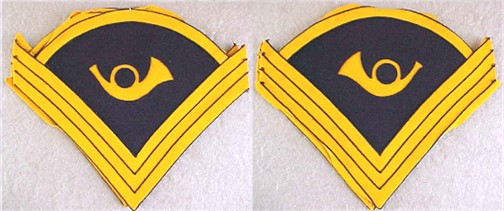 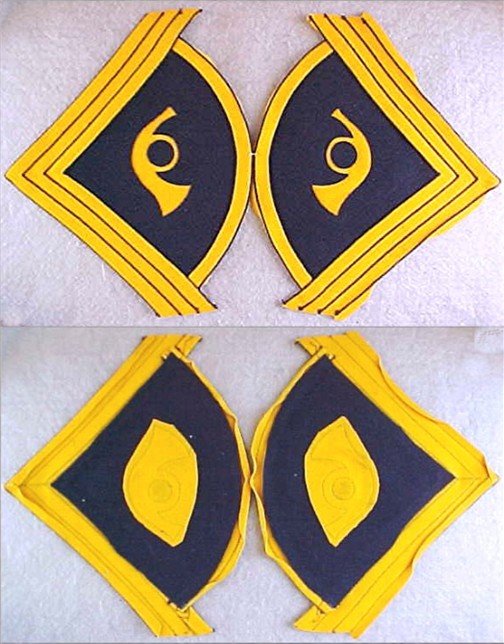
|
|
PATTERN 1872 CAVALRY TRUMPETER SERGEANT CHEVRON –
EXCELLENT UNISSUED CONDITION: Introduced with
the post Civil War uniform changes and continued in
service through the end of the Indian War era, this
insignia was officially known as the “Principal
Musician” Chevron, a non-commissioned officer rank.
This particular chevron would have been issued to a
musician – most likely one of the senior trumpeters –
serving in a cavalry regiment, indicated by the yellow
bars and horn.
In excellent condition, the insert and chevrons show no
evidence of use or age, no moth damage, and no soiling.
Given the limited numbers of trumpeters in any one
regiment, and certainly the few Principal Musicians,
this is a scarce piece of Indian War insignia, and one
that will be a very attractive display piece. (0426)
$175
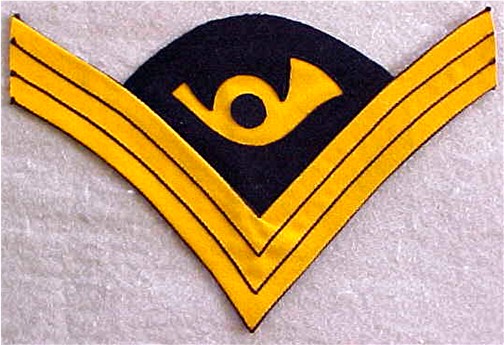
|
|
ca. 1889
SIGNAL CORPS CORPORAL CHEVRON –
EXCELLENT UNISSUED CONDITION: A like new
original late Indian War or Spanish American War eras US
Army Signal Corps Corporal chevron. With the
very limited number of Signalmen in the army, and even
fewer who were promoted to one of the noncommissioned
officer ranks, this is a relatively scarce insignia.
Worn on the upper sleeve of the soldier's uniform coat,
this distinctive enlisted insignia features a colorful
Signal Corps emblem on dark blue wool, creating an
attractive piece which will be a nice addition to your
collection. A complete unissued, unused brassard
with no damage or moth holes.
SOLD
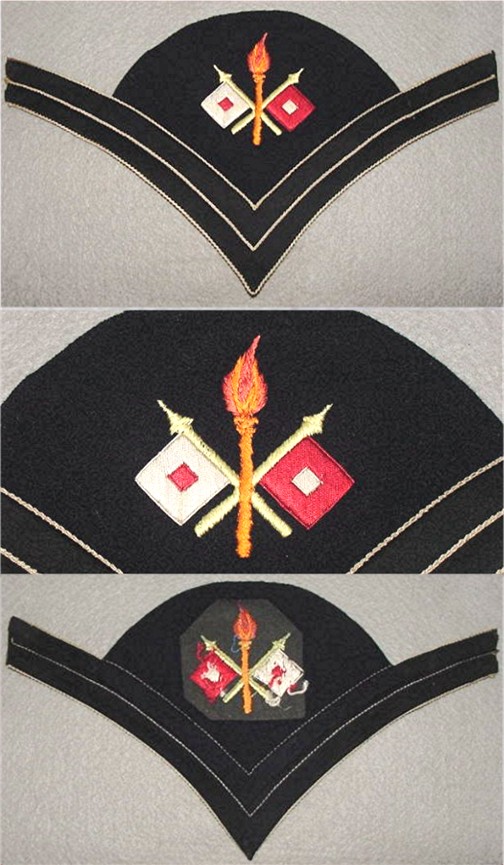
|
|
PATTERN 1892 CAVALRY SADDLER
BRASSARDS - SCARCE SPANISH AMERICAN WAR INSIGNIA:
Introduced just prior to the Spanish American War for
wear in the tropics, the khaki and white cotton uniforms proved to
be practical and serviceable additions to the soldier's
clothing options. In turn, the army added
cotton drill chevrons and brassards to the Pattern 1872
Chevrons which were worn on the dark blue wool uniforms.
Identical in form and color selections
as the
woolen brassards, these cotton drill brassards feature a
yellow wool saddler's knife approximately one quarter
the size of the Pattern 1872 Saddler Brassards sewn
on a khaki and a white cotton drill background.
As the number of Saddlers per regiment was
limited, this is a relatively scarce insignia.
Worn on the upper sleeve of the soldier's uniform coat,
this piece is one of the distinctive enlisted insignias
of the Spanish American War period.
These are the
brassards a cavalry regimental or company level saddler would have
worn in Cuba and the Philippine Islands during the last
decade of the 19th Century and the first few years of
the 20th Century.
Consistent with the low survival rate of the
early khaki uniforms, very few of these matching cotton
brassards appear on the market. This would be a nice
addition to your Spanish American War display.
I have the two single
specimens shown below.
*********
KHAKI
MOUNTED PATTERN 1892 CAVALRY SADDLER BRASSARD: In excellent condition, this
brassard shows very little evidence of use or age, and no
soiling. The stitching around the perimeter of the
brassard indicates it was sewn to a uniform coat at one
time. The wool saddler's knife shaped insignia is
full form and presents as close to like new condition as
you are likely to find. $75

WHITE DRILL
MOUNTED PATTERN 1892 CAVALRY SADDLER BRASSARD:
Showing some evidence of wear, this brassard has
suffered the effects of aging, but still survives as a
credible example of a scarce brassard of the period.
The wool saddler's knife shaped insignia has some
mothing on the right side, but still retains its shape
and form. The white cotton drill has some staining
in one spot, but is otherwise clean and the material is
very solid. $45
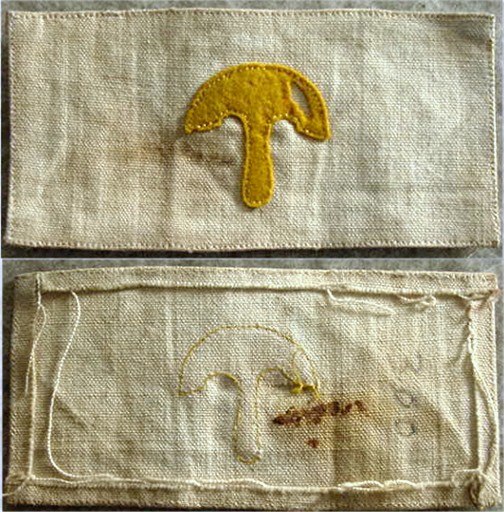 |
|
CAVALRY FARRIER BRASSARD: A like new
original Indian War Period US Army Cavalry Farrier
Brassard. As the number of Farriers (Horseshoers) per regiment was
limited, this is a relatively scarce insignia. Worn on
the upper sleeve of the soldier's uniform coat, this
piece is one of the distinctive enlisted insignias of
the Indian War period. The combination of Dark Blue,
Yellow, and Gray wool creates an attractive piece and makes for a
nice addition to your collection. A complete unissued,
unused brassard with no damage or moth holes.
(0131) $95
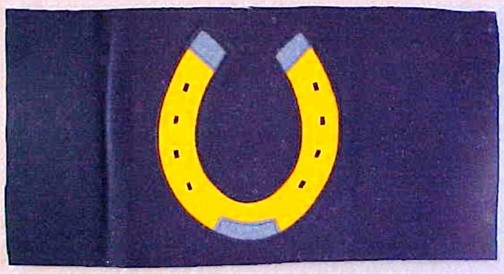
|
|
PATTERN 1872 CAVALRY QUARTERMASTER SERGEANT CHEVRON –
EXCELLENT UNISSUED CONDITION: Introduced with
the post Civil War uniform changes and continued in
service through the end of the Indian War era, the
Quartermaster Sergeant was one of the most senior, and
most important, non-commissioned officers on a frontier
army post. It was through his hands and by his
authority that all things related to the quality of life
of the soldier passed, including the buildings (such as
they were) in which they lived. He was a
contractor, a dietitian, a haberdasher, a tailor, a
horse trader, a freight and expressman, and a landlord,
and he was probably the one non-commissioned officer on
the post who could guarantee a reasonably good night's
sleep on a full stomach or a miserable sleepless night
on an empty one.
In excellent condition, this chevron show no
evidence of use or age, no moth damage, and no soiling.
Given the limited numbers of quartermaster sergeants in any one
regiment, this is a relatively scarce piece of Indian War insignia.
SOLD
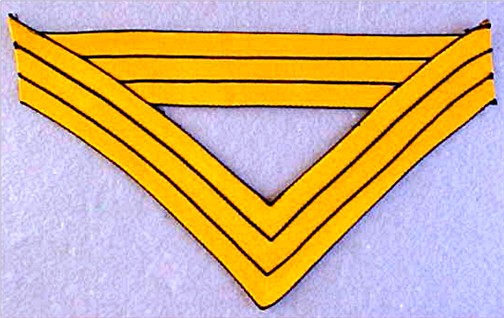
|
|
ca. 1889 ORDNANCE DEPARTMENT SERGEANT CHEVRON –
EXCELLENT UNISSUED CONDITION: A like new
original 1889 US Army Ordnance Department Sergeant
chevron. Differentiated from the red Artillery
chevrons, the Ordnance Department were made with a
deeper crimson color. With the very limited number
of Ordnance Department noncommissioned officers, this is
a relatively scarce insignia. Worn on the upper
sleeve of the soldier's uniform coat, this distinctive
enlisted insignia features a colorful Flaming Bomb
emblem on dark blue wool, creating an attractive piece
which will be a nice addition to your collection.
A complete unissued, unused brassard with no damage or
moth holes. (0420)
$150
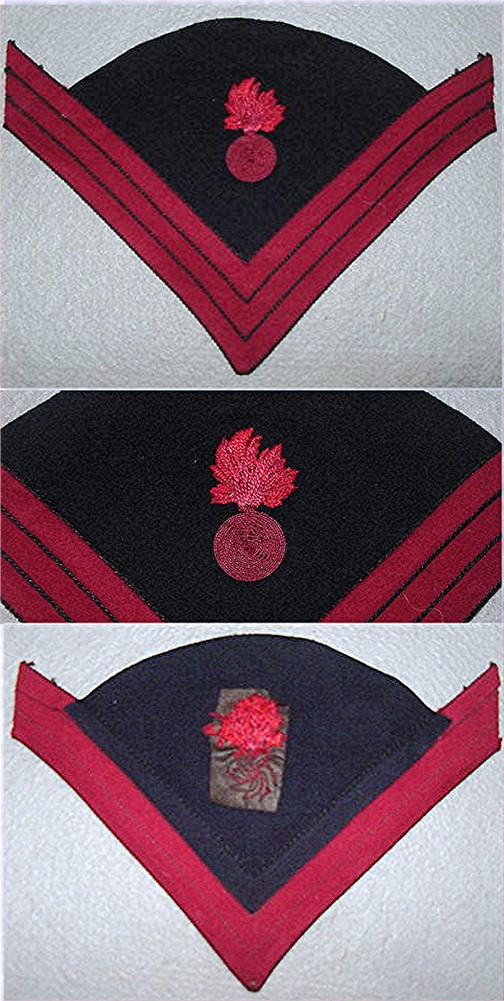 |
|
PATTERN 1899 CAVALRY SERGEANT CHEVRON –
EXCELLENT CONDITION: Introduced just prior
to the Spanish American War for wear in the tropics, the
khaki cotton uniforms proved to be a practical and
serviceable addition to the soldier's clothing options.
As a result, these cotton drill chevrons were added for
the new uniforms instead of the Pattern 1872 Chevrons
worn on the blue wool blouses. Identical in size
and color selections to the woolen chevrons, these
cotton drill chevrons incorporated the blue chain
stitched trim. This is the chevron a cavalry
sergeant would have worn in Cuba and the Philippine
Islands during the last decade of the 19th Century and
the first few years of the 20th Century.
In excellent condition, the chevron show no
evidence of use or age, and no soiling.
Consistent with the low survival rate of the early khaki
uniforms, very few of these matching cotton chevrons
appear on the market. This would be a nice
addition to your Spanish American War display.
(0133) $65
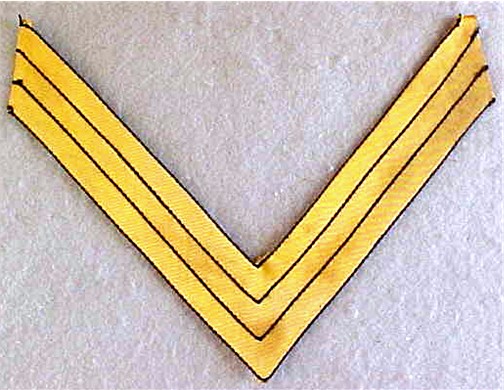
|
|
ca. 1879 INFANTRY CORPORAL GREAT COAT CHEVRONS -
EXCELLENT PAIR: This dark blue chevron was
introduced in 1879 specifically for the Infantry
soldiers to wear on the sleeves of their greatcoats,
rather than the white wool chevrons worn on their
blouses or five button sack coats as they are also
known. Of the same pattern and material as the standard
Model 1872 Infantry Chevrons, this pair of original
Indian War Period US Army Infantry Corporal Chevrons is
made of the same type of wool as the white chevrons and
is trimmed with a white cording per the regulations.
The chevrons are in excellent condition and show no
evidence of use, wear or soiling. This is an
attractive pair to display with an Indian Wars Infantry
grouping. (0801)
$65
 |
|
PATTERN 1888 HOSPITAL STEWARD
CHEVRON:
Introduced under General Order No. 6 in 1888, this
chevron was worn by a
Hospital Steward, the senior enlisted medical specialist
on the post. Incorporating the Maltese cross on a
blue field, this chevron replaced the previous hospital
steward's insignia of a single diagonal green wool
stripe bordered in gold cord with an embroidered gold
caduceus.
In very good condition,
there is some minor mothing at the crest of the blue
insert where it meets the arc of green wool across the
top of the chevron. The full extent of this
mothing can be seen in the photo below. I
intentionally placed the chevron against a lighter
background so the mothing would show, however displayed
against a dark blue background as the chevron would be
worn on a uniform coat, this mothing is almost
impossible to detect. This is not a commonly
encountered chevron and it is a colorful piece to add to
a collection of Indian Wars era insignia. (0130)
$75
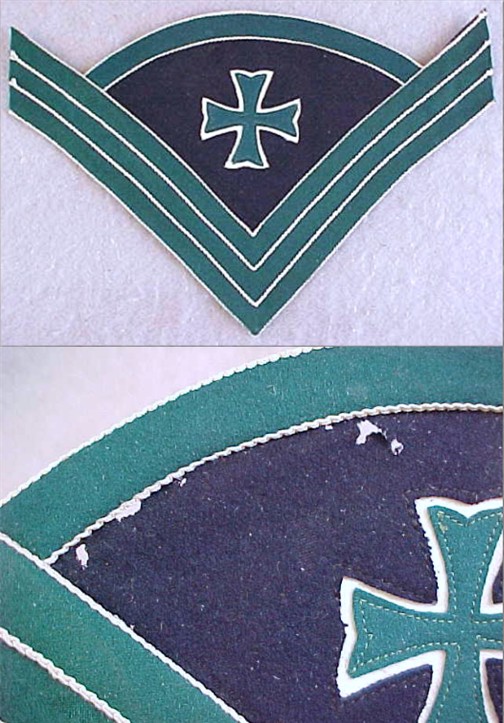
|
|
1899 INFANTRY BATTALION
SERGEANT MAJOR GREAT COAT CHEVRON – VERY NICE PIECE:
This is an original US Army Infantry Battalion Sergeant
Major’s Chevron, a rank added to the army’s rank
structure in 1899. Prior to this date, there was only
one sergeant major in each regiment. Since in practice,
most of the regiments were divided up, and detachments
of a single company, or in some cases a battalion made
up of several companies, were assigned to independent
posts or stations, the addition of a sergeant major at
the battalion level provided more supervision and
leadership for the soldiers.
These dark blue chevrons
were introduced in 1879 specifically for the Infantry
soldiers to wear on the sleeves of their greatcoats,
rather than the white wool chevrons worn on their
blouses or five button sack coats as they are also
known.
Of the same pattern and material as the standard Model
1872 Infantry Chevrons, this original US Army Infantry
Battalion Sergeant Major Chevron is made of the same
type of wool as the white chevrons and is trimmed with a
white cording per the regulations. The chevron is in
excellent condition and shows no evidence of use, wear
or soiling, and will be an interesting piece to display
with your collection. $50
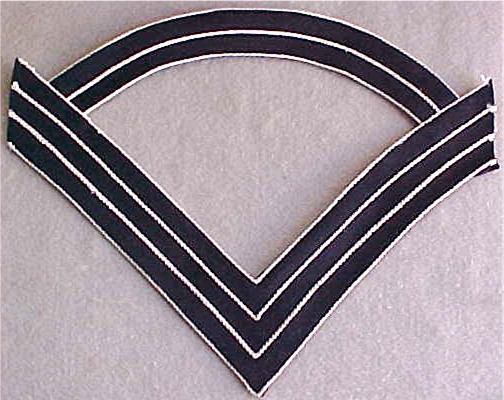
|
|
ca. 1892 CAVALRY LANCE CORPORAL CHEVRONS – VERY
NICE PAIR: These chevrons were introduced in
March of 1892 with the army’s establishment of the rank
of Lance Corporal. Of the same pattern and material as
the Model 1872 Chevrons, this pair of original Indian
War Period US Army Cavalry Lance Corporal Chevrons is
made of the same type and color of wool as the earlier
pattern chevrons - yellow wool trimmed with a dark blue
cording per the regulations. Both chevrons are in
excellent condition and show no evidence of use, wear or
soiling. This set will be an attractive piece to
display with your collection. $65
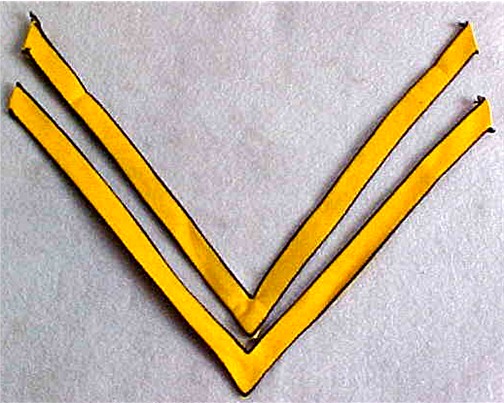
|
|
ca. 1879 INFANTRY CORPORAL GREAT COAT CHEVRON: This dark blue chevron was
introduced in 1879 specifically for the Infantry
soldiers to wear on the sleeves of their greatcoats,
rather than the white wool chevrons worn on their
blouses or five button sack coats as they are also
known. Of the same pattern and material as the standard
Model 1872 Infantry Chevrons, this original
Indian War Period US Army Infantry Corporal Chevron is
made of the same type of wool as the white chevrons and
is trimmed with a white cording per the regulations.
The chevron is in excellent condition and shows no
evidence of use, wear or soiling. This is an
attractive piece to display with your collection.
$25
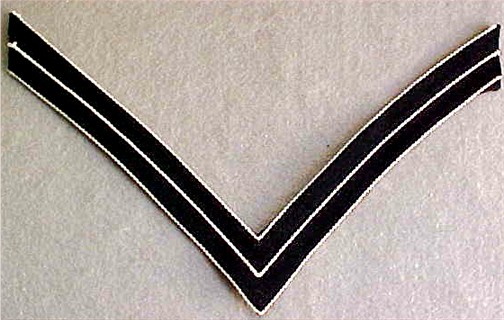
|
|
PATTERN
1872 CAVALRY ORDNANCE SERGEANT CHEVRON INSERT:
Introduced with the post Civil War uniform changes and
continued in service through the end of the Indian War
era, this chevron insert was sewn into the "V" of the
sergeant's chevron to identify the soldier as an
Ordnance Sergeant serving in the cavalry as indicated by
the yellow wool outlining the center star. In
excellent condition, this insert shows little evidence
of use or age, having no moth damage and only some
slight soiling which likely collected under the stripe
when the insert was part of the full chevron. A
scarce piece of Indian War insignia and a very
attractive display piece.
SOLD
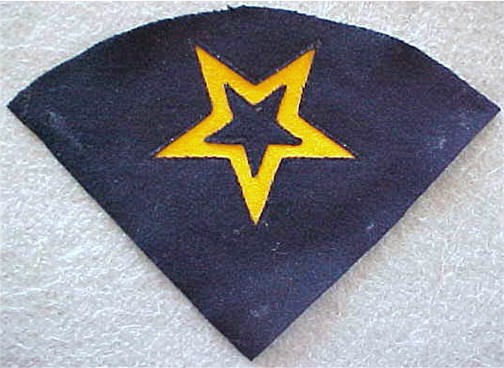
|
|
PATTERN 1888 INFANTRY SERGEANT GOLD LACE CHEVRON
FOR WEAR ON THE DRESS COAT –
EXCELLENT UNISSUED CONDITION: Introduced
under General Order No. 6 in 1888, these gold lace
chevrons were to be worn on the soldier's dress coats.
A much dressier departure from the wool chevrons that
had served for both the service blouse and the dress
coat since 1872, the addition of these gold lace
chevrons dramatically improved the appearance of the
dress uniforms. This
chevron was worn by an infantry sergeant, indicated by
the gold lace applied to a white wool field - white
having replaced light blue as the facing color for
infantry under the same general order cited above.
In excellent condition, the chevrons and wool facing show no
evidence of use or age, no moth damage, and no soiling.
Gold lace chevrons are not particularly common and when
found, are seldom in this fine condition.
SOLD
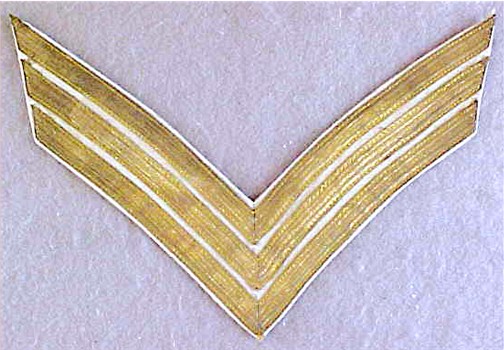 |
|
PATTERN 1892 CAVALRY REGIMENTAL
SERGEANT MAJOR CHEVRONS – PAIR – EXCELLENT CONDITION:
Introduced just prior to the Spanish American War for
wear in the tropics, the khaki cotton uniforms proved to
be a practical and serviceable addition to the soldier's
clothing options. In addition, the army added these
cotton drill chevrons to replace the Pattern 1872
Chevrons. Identical in size and color selections to the
woolen chevrons, these cotton drill chevrons were sewn
on a dark blue wool field so they could be worn on the
dark blue blouse, the dark blue wool shirt, or trimmed,
they could be worn on the khaki blouse. This is the
chevron a cavalry regimental sergeant major would have
worn in Cuba and the Philippine Islands during the last
decade of the 19th Century and the first few years of
the 20th Century.
In excellent condition, the
chevron shows no evidence of use or age, and no
soiling. Consistent with the low survival rate of the
early khaki uniforms, very few of these matching cotton
chevrons appear on the market. This would be a nice
addition to your Spanish American War display.
SOLD
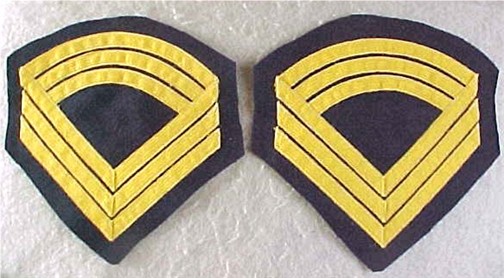 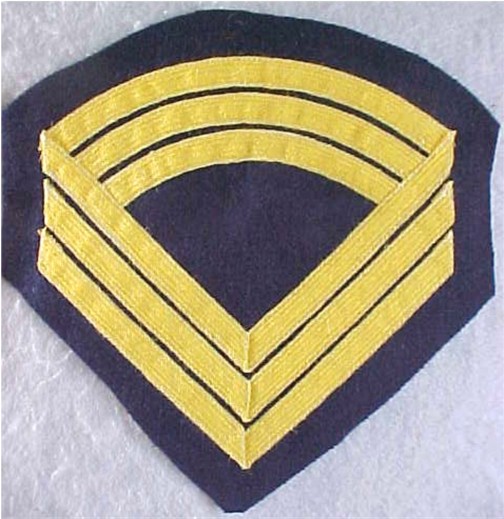 |
|
|

